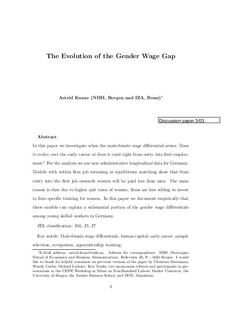| dc.contributor.author | Kunze, Astrid | |
| dc.date.accessioned | 2006-08-04T09:01:30Z | |
| dc.date.available | 2006-08-04T09:01:30Z | |
| dc.date.issued | 2003-01 | |
| dc.identifier.issn | 0804-6824 | |
| dc.identifier.uri | http://hdl.handle.net/11250/162676 | |
| dc.description.abstract | In this paper we investigate when the male-female wage differential arises: Does
it evolve over the early career or does it exist right from entry into first employment?
For the analysis we use new administrative longitudinal data for Germany.
Models with within firm job rationing or equilibrium matching show that from
entry into the first job onwards women will be paid less than men. The main
reason is that due to higher quit rates of women, firms are less willing to invest
in firm specific training for women. In this paper we document empirically that
these models can explain a substantial portion of the gender wage differentials among young skilled workers in Germany. | en |
| dc.format.extent | 217670 bytes | |
| dc.format.mimetype | application/pdf | |
| dc.language.iso | eng | en |
| dc.publisher | Norwegian School of Economics and Business Administration. Department of Economics | en |
| dc.relation.ispartofseries | Discussion paper | en |
| dc.relation.ispartofseries | 2003:3 | en |
| dc.subject | male-female wage differentials | en |
| dc.subject | human capital | en |
| dc.subject | early career | en |
| dc.subject | sample selection | en |
| dc.subject | occupation | en |
| dc.subject | apprenticeship training | en |
| dc.title | The evolution of the gender wage gap | en |
| dc.type | Working paper | en |
